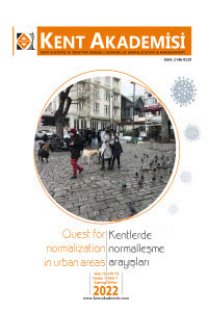Kentsel Alanlarda Suyun Metabolik Döngüsü: Türkiye Analizi
su, Kent Metabolizması, Sürdürebilirlik, Suyun Metabolik Döngüsü
Metabolic Water Cycle in Urban Areas: Turkey Analysis
Water, Urban Metabolism, Sustainability, Metabolic Cycle of Water,
___
- Ayres, Robert U. and Kneese, Allen V. (1969), Production, Consumption, and Externalities The American Economic Review Vol. 59, No. 3 pp. 282-297.
- Barles, Sabine (2009). Urban Metabolism of Paris and its Region, Journal of Industrial Ecology, 13, pp. 898-913.
- Carréon, Jesús Rosales, and Worrell, Ernst (2018). Urban Energy Systems Within The Transition to Sustainable Development: A Research Agenda for Urban Metabolism, Resources, Conservation and Recycling, 132, pp. 258–266.
- Codoban, Natalia and Kennedy, Christopher A. (2008). The Metabolism of Neighbourhoods, ASCE Journal of Urban Planning and Development, 134(1), pp. 21-31.
- Collins, Andrea and Flynn, Andrew (2007). Engaging with the Ecological Footprint as a Decision-Making Tool: Process and Responses, Local Environment, 12(3), pp. 295–312.
- Fischer-Kowalski, Marina and Huttler, Walter (1997). Society's Metabolism: The İntellectual History of Materials Flow Analysis Part II, 1970–1998, Journal of Industrial Ecology, 2(4), pp. 107–136.
- Girardet, Herbert (1990) “The metabolism of cities. In: Cadman”, D., Payne, G. (Eds.), The Living City: Towards a Sustainable Future. Routledge, London, pp.170-180.
- Grimm, N.B., Faeth, S.H., Golubiewski, N.E., Redman, C.L., Wu, J., Bai, X. and Briggs, J.M. (2008). Global Change and The Ecology Of Cities, Science, 3 (58), pp.756–760.
- Huang, Shu‐Li and Chen, Chia‐Wen (2009). Urbanization and Socioeconomic Metabolism in Taipei, Journal of Industrial Ecology, 13, pp. 75-93.
- Kennedy, C., Cuddıhy, J. and Engel-Yan, J. (2007). The Changing Metabolism Of Cities, Journal Of Industrial Ecology, 11, pp. 43-59.
- Kennedy, C., Cuddıhy, J. and Engel-Yan, J. (2007). The Changing Metabolism Of Cities, Journal Of Industrial Ecology, 11, pp. 43-59.
- Kennedy, C., Pincetl, S. and Bunje, P. (2011). The Study of Urban Metabolism and its Applications to Urban Planning and Design, Environmental Pollution, 159, pp. 1965–1973.
- Moffatt, Ian (2000). Ecological Footprints and Sustainable Development, Ecological Economics, 32, pp. 359-362.
- Newman, Peter (1999). Sustainability and Cities: Extending The Metabolism Model, in Landscape and Urban Planning, 44, pp. 219–226.
- Swilling, Mark and Annecke, Eve (2012). Just Transitions: Explorations of Sustainability in an Unfair World, Japan: United Nations University Press.
- Wolman, A. (1965). The Metabolism of Cities, Scientific America, 213 (3), pp.179-190.
- ISSN: 2146-9229
- Yayın Aralığı: Yılda 4 Sayı
- Başlangıç: 2008
- Yayıncı: Karadeniz Yazarlar ve Şairler Derneği
Kentsel Alanlarda Suyun Metabolik Döngüsü: Türkiye Analizi
Çevre Kalitesi ve Mutluluk İlişkisi Ekseninde Yeşil Kentler & Mutlu Ülkeler
Seval CÖMERTLER, Necmiye CÖMERTLER
Gülçinay BAŞDOĞAN, Berivan TURAN
Eskişehir Kenti Porsuk Çayı Kıyısında Mekânsal Örüntü ve Suyla Kurulan Bağlantının Analizi
Gül ŞİMŞEK, Ayşe Deniz YEŞİLTEPE
Üniversite Öğrencilerinin Rekreasyonel Eğilimlerinin Karşılaştırmalı Analizi: Çankırı Örneği
Ozgur Burhan TİMUR, İbrahim AYTAŞ, Umut PEKİN TİMUR
Site ve Toplu Konut Bahçelerindeki Açık ve Yeşil Alanların İrdelenmesi: Isparta Kent Merkezi Örneği
Şiddetin Toplumsal Taşıyıcısı Olarak Flört Şiddeti: Ankara Örneği
Peyzaj Alanları Planlamasında SITES Sertifikasyon Sistemi
Otantik Kültürde Kent Kimliği ve Kültürel Peyzaj İlişkisinin Erzurum İli Örneğinde İrdelenmesi
Sena Nur ANGIN, Elif AKPINAR KÜLEKÇİ, Hasan YILMAZ
COVID-19 Döneminde Hareketlilik: İstanbul Kent içi Toplu Ulaşım
